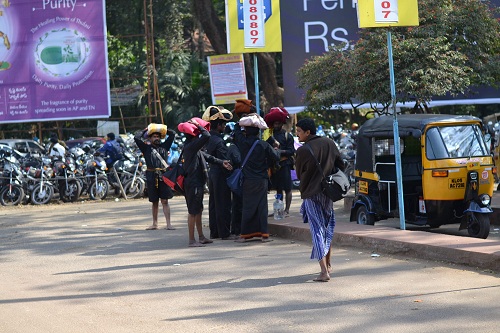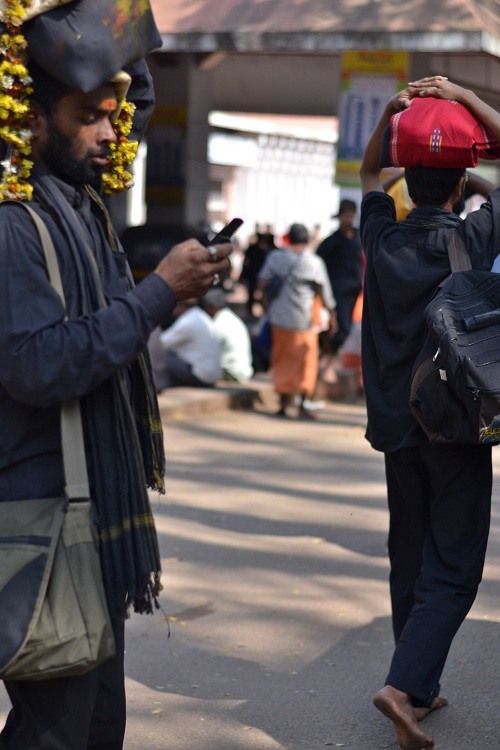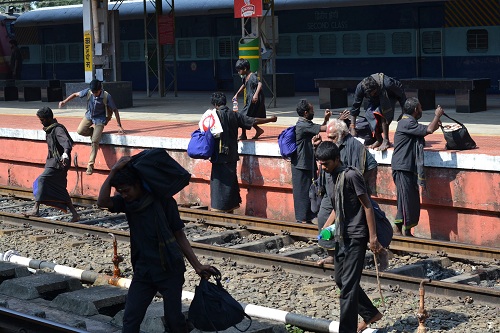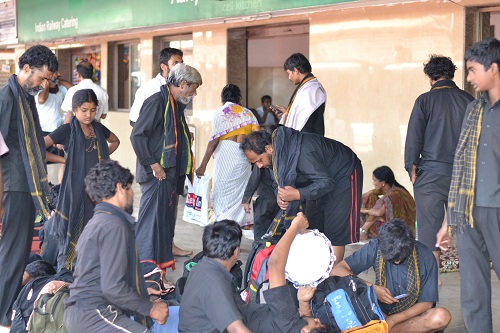Since we arrived in South India we’ve seen hoards of barefoot men clothed in black mundus. Most carry bundles on their heads and all walk with purpose.

These are worshipers of Ayappa, a Hindu deity and child of lord Shiva and lord Vishnu’s female avatar Mohini. They are participating in an annual pilgrimage to their main shrine in Sabarimala, believed to be the place where Ayappa meditated after killing the demon Mahishi.
Pilgrims are meant to be celibate, vegetarian, and intoxicant-free for 41 days before setting out on a 61 kilometer walk along a forest route to Sabarimala. The journey takes four days and the pilgrims carry nothing but offerings on their heads and a rucksack with personal items. (And we thought we traveled light.) One may be so devoted as to forego shoes and worldly comforts for days, but this particular devotee felt his cellphone a necessity.

Pilgrims that don’t make the walk crowd trains and buses, perhaps believing that their devotion gives them protection against high voltage and moving locomotives.

Whatever mode of transportation is used, the pilgrims travel in packs, with an assigned leader. Women of childbearing age are not allowed at Sabarimala. This is in respect for (and concern over?) Ayappa’s celibacy. The result is packs of men bursting into chanting, singing, and general merriment.

While the pilgrimage looks like a time of bonding and jubilation, it has not been without its consequences. 106 people were trampled to death during last year’s pilgrimage. This year, 34 heart related deaths have been reported.
It is estimated that 4 to 5 million people attend the annual pilgrimage to Sabarimala. If this is correct, the event rivals attendance at the Muslim Haj to Mecca. The only other pilgrimage that can claim higher attendance is Kumbh Mela, also in India. Large gatherings come easily to a country of over 1 billion people.

My parents have often talked about Sabarimala but it was great to read a lot of the background history you provided. Very informative ! My dad has actually gone there once just to experience it 🙂
That is so interesting. I am going to ask him about the trip! Sandeep brushed it off – I guess he grew up seeing the pilgrims and it was no big deal to him – so it was a learning experience for all of us.
Diya the way you have written the importance & the history attached to Lord Ayappa I am learning from your wonderful in depth revelation .Thanks Diya,as all these years we learnt many big & small people observed the rituals & spoke the significance of the Sabarmalai Diety,but no one has described the divinity of such an importance shrine .
I am so happy that I could shed a new light on the event. It was very interesting to witness.